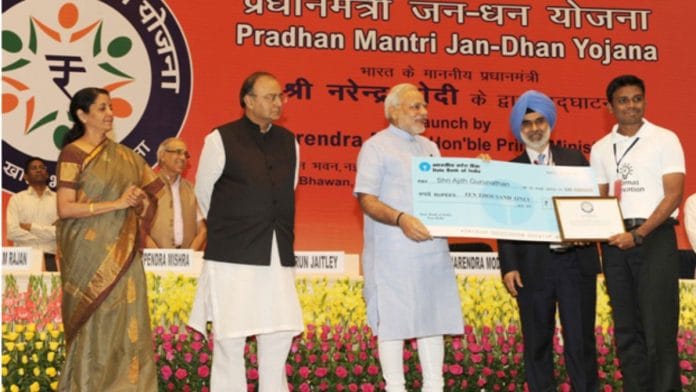New Delhi: The Pradhan Mantri Jan Dhan Yojana (PMJDY) has completed a decade. Over 53 crore citizens currently have bank accounts under the scheme, which was launched by the Prime Minister Narendra Modi-led government in 2014 with the aim of driving financial literacy, inclusion and social security.
According to data shared by the prime minister in a social media post Wednesday, these account holders have made deposits of more than Rs 2.3 lakh crore. Nearly 30 crore of the beneficiaries are women.
In a post on LinkedIn, Modi wrote that the initiative was “an endeavour to build an India where each and every citizen, irrespective of one’s economic background, has access to the formal banking apparatus”.
He also highlighted that the benefits of the scheme managed to reach those outside the metropolitan cities, as 65 percent of the Jan Dhan account holders are either in rural or semi-urban areas. Crores of families from the Scheduled Castes (SC), Scheduled Tribes (ST) and Other Backward Classes (OBC), have also been positively impacted, he wrote.
Finance Minister Nirmala Sitharaman called the scheme a “people’s movement” in a post on X.
A progressive step was taken on this day 10 years ago for financial inclusion. PM Modi launched this initiative to ensure crores of our people who didn’t benefit from formal coverage of financial services are brought in to benefit. Over 53 crore accounts with over ₹ 2.3 lakh… https://t.co/jhS2Tmm34I
— Nirmala Sitharaman (@nsitharaman) August 28, 2024
The government has said that the Jan Dhan Yojana has successfully resulted in higher savings, increased access to credit, bridging the gender gap in terms of access to financial services and positive social impacts including a drop in the crime rate, and reduced alcohol and tobacco consumption.
Calling it a “vital pillar” of the “JAM Trinity (Jan Dhan, Aadhaar, Mobile)”, the prime minister said that the scheme has facilitated direct transfers in almost all of the government’s flagship programmes, like Ayushman Bharat, PM-Kisan, and so on. Direct transfers worth almost Rs 39 lakh crore have taken place, according to data shared by him.
Also Read: Demonetisation failure? Rs 500 & Rs 2,000 notes together make up 50% of counterfeit notes detected
‘Need for literacy, more data’
The benefits of the Jan Dhan Yojana, as listed by the government, include the absence of any requirement to maintain a minimum balance in accounts, provision of RuPay debit cards to account holders, accident insurance cover of Rs 1 lakh, and overdraft (OD) facility of up to Rs 10,000, among others.
In 2018, the focus of the scheme was extended to “every unbanked adult”, rather than just “every household”.
According to a World Bank report, the ‘JAM Trinity’ has boosted the financial inclusion rate in India from 25 percent in 2008 to over 80 percent of adults in the past six years.
Madan Sabnavis, chief economist at Bank of Baroda told ThePrint that 10 years of Jan Dhan Yojana have resulted in the financial inclusion of many households by giving them access to banking facilities. “I don’t have numbers, but I am sure they are substantial. Money is getting transferred through these bank accounts,” he said.
However, he added that the average bank balance has not gone up, meaning that a lot of people are not saving their money in these accounts.
“Most of the account holders come from poor backgrounds. They are usually not even aware of the benefits that they can get, such as remitting and borrowing,” Sabnavis said.
He further emphasised that there is a need to increase literacy and that there should be more conversations regarding informing people about the perks of the Yojana.
Economist Gurcharan Das said that Jan Dhan Yojana is the “definition of financial inclusion”.
“Ordinary people had it difficult before this. They would have to hide their money under their mattresses. PMJDY has provided them, especially women, with security and safety. Now millions of people have bank accounts. It is empowering,” he said.
However, Yamini Aiyar, former CEO of the Centre for Policy Research, said that while the scheme has ensured a “significant shift in the architecture of welfare programmes” via direct benefit transfers (DBT), more data and evaluation are needed to understand its welfare impact.
“Building robust grievance redressal systems, and ensuring that those left out can still access welfare benefits require corrective steps to be taken within the DBT architecture… We must also push for greater data and evaluations to understand the strengths of this effort (Jan Dhan Yojana) and what more needs to be done to ensure that citizens’ rights are protected fully,” she told ThePrint.
Also Read: Indian govt has a physics problem—time travelling to change tax laws will hurt business






